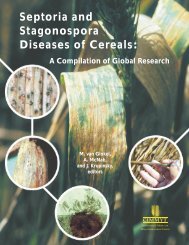Section 3 (Crop Management)
Section 3 (Crop Management)
Section 3 (Crop Management)
You also want an ePaper? Increase the reach of your titles
YUMPU automatically turns print PDFs into web optimized ePapers that Google loves.
Rajbhandari<br />
Extensively cited data of Dalal (1974) indicated that total P uptake (6 and 16 weeks after planting) by<br />
sole crop maize was greater than a maize/pigeonpea intercrop. The intercrop pigeonpea P uptake was less<br />
than that of the sole crop at 6 and 16 weeks after planting, but at 24 weeks there was no difference<br />
between sole and intercrop P uptake. The soil P status remained unaffected 16 weeks after planting.<br />
Srinivasan and Ahlawat (1983) also recorded no difference in soil P status between sole crop pigeonpea<br />
and intercrop with green gram or sorghum. Wahua (1983) observed no difference between P uptake (up to<br />
50 DAP) of sole and intercrop maize; however, at higher fertility levels uptake by the sole crop was<br />
greater than intercrop and the reverse was true at lower fertility levels. The uptake by intercrop cowpea<br />
was much lower than the sole crop 40 days after planting. CIAT (1980) reported lower P concentration in<br />
leaves of intercropped cassava and cowpea compared to sole crops. Mason et al (1986) observed that<br />
intercropping cassava with cowpea reduced the P concentration in leaf, stem and storage roots of cassava<br />
at early growth stages (till 80 days after planting) but not after. Most of the experiments reviewed were<br />
conducted with adequate P fertilization, and none of them dealt with intercrop response to P across a<br />
range of P levels in different environments.<br />
Intercrop systems have been advocated to be more efficient in land use compared to sole crop<br />
systems, and therefore suitable and desirable in sustainable agriculture. It is unclear whether the increased<br />
efficiency is due to only more resource extraction or to more efficient conversion of resources to dry<br />
matter and marketable yield.<br />
The experiment under different environments were conducted with the following objectives:<br />
• To compare the growth in dry matter and grain yield maize and soybean in maize/soybean and<br />
maize/rice intercrops with sole crops under different environments.<br />
• To quantify the effect of interspecific competition on P uptake and conversion efficiency of<br />
intercrops compared to sole crops under different P availability.<br />
Materials and Methods<br />
Two sites in Hawaii, having contrasting soil and climatic conditions, were utilized to conduct an<br />
experiment in three environments. Permanent plots were utilized for the intercropping experiments, where<br />
ten target phosphorus concentration in soil solution have been established since 1971. The field trial at<br />
Wailua Experiment Station, Kauai, was planted on a highly weathered clayey, sesquic, isothermic,<br />
Anionic Acrudox. Two field trials were conducted during the summers of 1988 and 1989 at the<br />
University of Hawaii Poamoho Experiment Station on a silty clay of the Wahiawa series classified as<br />
clayey, kaolinitic, isohyperthermic, Rhodic Eutrustox.<br />
Main plots of ten target P levels (0.003, 0.006, 0.012, 0.025, 0.05, 0.1, 0.2, 0.4, 0.8, 1.6 mg P/L in soil<br />
solution) were laid out in an augmented block design (Federer 1956). The target P levels in soil solution<br />
were achieved using phosphorus sorption techniques (Fox and Kamprath 1970). Appropriate amounts of<br />
P fertilizer in each treatment were applied as triple superphosphate before the last tillage operation to<br />
achieve the targeted levels of P in soil solution. In Kauai the four middle P levels (0.025, 0.05, 0.1 and 0.2<br />
mg P/L) were replicated three times, the four extreme levels (0.003, 0.006, 0.8 and 1.6 mg P/L) occurred<br />
only once and the remaining two (0.012 and 0.4 mg P/L) were replicated twice. Each of 20 main plots<br />
(12.19 m by 9.14 m) contained each of the three sole crops (maize, rice and soybean) along with<br />
maize/rice and maize/soybean intercrops. In Poamoho, four P levels, 0.012, 0.025, 0.050 and 0.100 mg<br />
P/L, were replicated three times and the rest of the unreplicated treatments constituted the 18 main plots<br />
(15.24 m by 5.49 m). Each main plot in 1988 contained one of the sole crops (maize, rice or soybean) and<br />
the two intercrop patterns. In 1989, main plots contained the maize/soybean intercrop with both maize<br />
and soybean sole crops. Maize spacing was 0.90 m by 0.25 m for both sole crop and intercrop. Sole crop<br />
- 215 -









